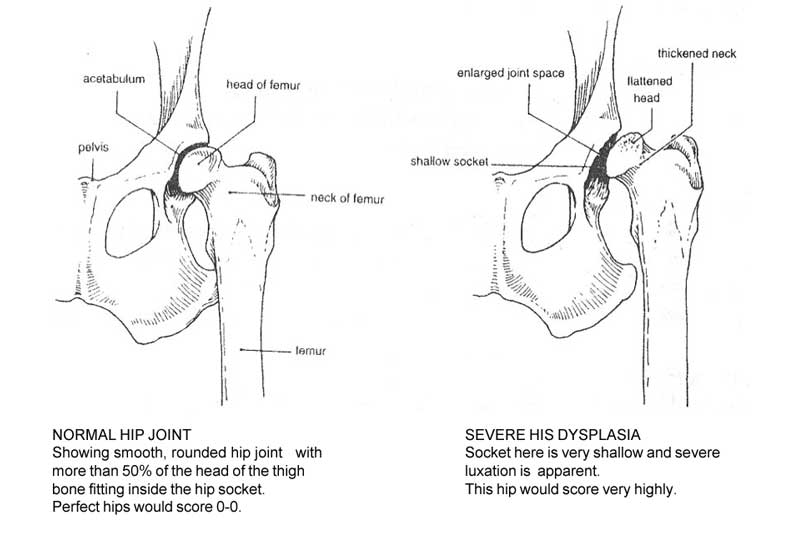DISEASES AFFECTING THE WELSH SPRINGER SPANIEL
FACT SHEET 1 – HIP DYSPLASIA
WHAT IS HIP DYSPLASIA?
Hip Dysplasia (HD) is a malformation of the hip joint ('dys: meaning bad and 'plasia' form)
The hip joint is a ball and socket joint, the ball being the femoral head, and the socket the acetabulum.
WHAT SIGNS SHOULD I LOOK FOR?
The symptoms may include: sitting awkwardly, with the weight of the body being taken by the forequarters, a reluctance to rise from the sitting position, floppiness in the hind legs when moving, moving with a sawing gait or 'bunny-hopping' when trotting, resting during a normal distance walk.
Sometimes at a walking pace, a dog will show a marked sway and the pelvis appears to rise and fall with each step.
WHAT IS THE NORMAL AGE FOR THE PROBLEM TO MANIFEST ITSELF?
HD is usually observed between four and six months of age when the rate of development of the puppy is at its most rapid. It progresses significantly between then and eighteen months of age, with most of the changes developing before two years old. In adult dogs, the changes that began in early life may result in hip arthritis in middle or old age. The dog may then become lame even though no signs were noticed when it was a puppy.
WHAT CAUSES HIP DYSPLASIA?
Genetic and environmental factors influence the development of Hip Dysplasia and affect the final degree of lameness and disability: The genetic mode of inheritance of HD is polygenic (multi-gene)
The environmental factors of most importance are:
- Feeding a correct diet that allows the puppy to grow at a steady pace. The puppy or dog should not be allowed to get fat. If a puppy is excessively heavy at a young age, it can lead to overloading of the soft cartilage of the developing joint and resulting deformation.
- Over exercise of dogs with unstable joints will exacerbate any wear and tear of the hips. Exercise should be restricted in young dogs, particularly those with hip problems.
- Floor surfaces should not be slippery, and puppies should not be allowed to climb stairs or steps.
IS THERE ANY TREATMENT?
There are many courses of action that your Veterinary Surgeon may take. Almost certainly, he or she will take an X-Ray of the hips to ascertain the degree of dysplasia in each hip (It may not be equal)
Rest and anti-inflammatory drugs will often help dogs showing pain after exercise. He or she may prescribe pain killing drugs, and if necessary others to help if arthritis proves a problem in later life. In very severe cases, the Veterinary Surgeon may consider amputation of the femoral head and/or a total hip replacement.
WHAT IF I SUSPECT MY DOG HAS HIP DYSPLASIA?
Contact your Veterinary Surgeon and the breeder of your puppy for advice and support.
Dogs with clinical HD should not be bred from
HOW DO I ENSURE THE PUPPY I BUY DOES NOT HAVE HIP DYSPLASIA?
You cannot. Hip Dysplasia is a most complex subject. You can help by selecting from animals that have good hips and by ensuring the environmental factors above are adhered to. It is advisable for you to acquaint yourself with the status of hips within the breed, and to consider purchasing from a breeder who can supply details of the dogs in their kennel.
WHAT ABOUT ROUTINE HIP X-RAYING?
Under Kennel Club/British Veterinary Association Scheme, dogs over one year old may be X-Rayed and scored. Each hip is scored under nine predetermined criteria. An excellent pair of hips would score 0-0, and the worst possible score is 53-53 (total 106). The Welsh Springer Spaniel breed has a mean average score of 18. The score demonstrates the clinical status of the hips, but does not absolutely reflect the potential for transmission of HD of an individual dog. However, by careful selection breeders should aim to improve or at least maintain good hip status.
BREEDING GUIDELINES
In order to improve the hip status of the breed and reduce the risk of breeding animals with HD, it is advised that breeders ideally use animals that have scores below the breed average. However, hips are only one part of the dog and improving the hip status should not be at the expense of temperament, type, soundness or other health issues.
FURTHER INFORMATION
The British Veterinary Association – Canine Health Scheme 7, Mansfield Street, London W1M 0AT, produce a useful leaflet 'Hip Dysplasia in Dogs- A Guide for dog owners' by John Foster. It is available free of charge (please enclose an A4 size SAE)
A list of published hip scores for Welsh Springer Spaniels can be obtained from the Kennel Club. Contact Gary Johnson at the Kennel Club to order the report, and current cost ( This e-mail address is being protected from spambots. You need JavaScript enabled to view it ).
Dated: November 2015
Click here to download this document as a PDF
Other fact sheets are produced by the WSS Joint Health Group.
Contact the Secretary for further information.













